
Original Link: https://www.anandtech.com/show/1247
Soltek SL-PT880Pro-FGR: VIA Dual-Channel for the Pentium 4
by Wesley Fink on February 23, 2004 4:58 PM EST- Posted in
- Motherboards
VIA has had a difficult time recently in the Intel chipset market. After making great in-roads since the Intel Rambus/i820 setbacks, VIA stubbornly stuck to a course that created a legal battle with Intel over licensing. They continued to produce decent chipsets for Pentium, but manufacturers wouldn't touch the chipsets due to legal concerns. Instead, manufacturers chose either Intel or the licensed SiS chipsets for their Pentium 4 boards. The legal problems with Intel were resolved eventually, but by that time, Intel had moved the chipset world to Dual-Channel memory.
With that shift to Dual-Channel memory, VIA seemed to have a difficult time producing a Dual-Channel solution for either Intel or AMD, and they continued to lose market share to Intel, SiS and nVidia. Finally, with last September's introduction of the Athlon 64, VIA was back with AMD. The K8T800 proved to be a decent and good-selling chipset in both the single-channel and dual-channel versions. It is true that the memory controller with Athlon 64 is on the CPU itself, but VIA had a new modern 8237 Southbridge that could now compete with the best from Intel. With the renewed success in the Athlon 64 market, VIA once again set their sights on the Pentium 4 chipset market. The VIA PT880 chipset is VIA's first dual-channel solution for Intel, and VIA has been very excited about prospects for the chipset.
Soltek is the first shipping PT880 chipset board that we have seen, but there will likely be more boards based on the PT880 in the near future. Soltek decided to give the PT880 a top-of-the-line treatment with the launch of their newest PRO series, and this is certainly the most feature-laden Soltek board that we have ever tested. Soltek even includes dual SATA RAID options, and a single IDE RAID connector - options that are more reminiscent of a top-line Asus board.
A Closer Look at VIA PT880
Compared to the earlier VIA P4X400 chipset, PT880 brings VIA completely up-to-date in features for the Pentium 4 platform.| Feature | PT800 | P4X400 |
| North Bridge | ||
| Processor Support | Intel® Pentium® 4 | Intel® Pentium® 4 |
| Hyper Threading Support | Yes | Yes |
| Front Side Bus | 800/533/400MHz | 533/400MHz |
| Memory Support | DDR400/333/266 w/ECC | DDR400/333/266 |
| Max Memory | 8.0GB | 4.0GB |
| AGP Support | AGP 8X/4X | AGP 8X/4X |
| South Bridge | VT8237 | VT8235 |
| North/South Bridge Link | 8X V-Link (533MB/sec) | 8X V-Link (533MB/sec) |
| Integrated Audio | VIA VinylTM Audio integrated 5.1 surround sound | VIA VinylTM Audio integrated 5.1 surround sound |
| Integrated Modem | MC'97 | MC'97 |
| Integrated Network Controller | VIA MAC 10/100 Ethernet | VIA MAC 10/100 Ethernet |
| PCI Devices/Slots | 6 slots Dual Channel Serial ATA directly supports two SATA devices |
6 slots |
| SATA | SATAliteTM interface expands support for two additional SATA devices |
No |
| V-RAID | RAID 0, RAID 1, and RAID 0+1 & JBOD (SATA) | No |
| PATA | Dual Channel Parallel ATA133 (up to 4 devices) | Dual Channel Parallel ATA133 (up to 4 devices) |
| USB | 8 ports | 6 ports |
| Super I/O | LPC Super I/O | LPC Super I/O |
| IO APIC | Yes | Yes |
| Power Management | ACPI/APM/PCI/PM | ACPI/APM/PCI/PM |
The big news, of course, is support for Dual-Channel memory, but it is also worth mentioning that the PT880 supports up to 8GB of Dual-Channel memory. The 8237 South Bridge has been paired with K8T800 for the last few months, so the contemporary feature-set is familiar. With full support for SATA, SATA RAID, base code for VIA vinyl audio, built-in 10/100 Ethernet LAN, and 8 USB ports, the 8237 competes well with the best from any chipmaker.
VIA calls their new Dual-Channel Memory Controller FastStream64. VIA says that they have used an expanded array of prefetch buffers to reduce latency in the memory controller. They claim that this provides similar performance to Intel's Dual-Channel controller at a lower transistor cost.
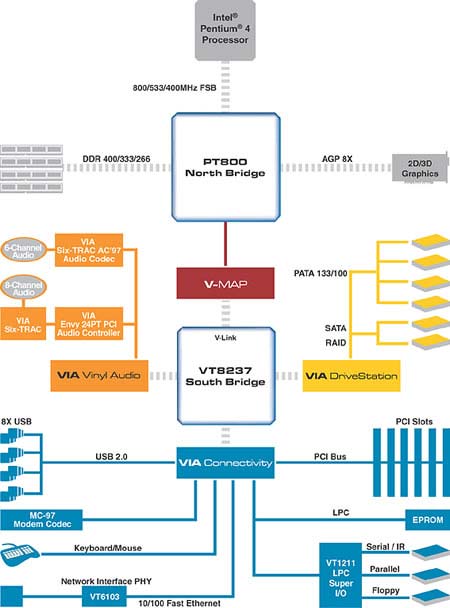
Like the recently introduced SiS 655TX, VIA also fully supports all Socket 478 processors, including the latest Prescott and P4EE. VIA Vinyl audio is supported by the 8237. Codecs can be used by the board maker for either 6-channel AC '97 audio or the very high quality Vinyl Envy 24 audio.
Key Features
- Supports full range of Intel® Pentium® 4 processors
- Supports Hyper-Threading Technology
- 800/533/400MHz FSB settings
- Supports up to 8GB DDR400/333/266 SDRAM with ECC
- Support for AGP 8X/4X
- V-Link 533 MB/sec high bandwidth North/South Bridge interconnect
- Support for VIA VinylTM Multichannel Audio Suite
- Serial ATA support for up to 4 devices
- Integrated V-RAID with RAID 0, RAID 1, RAID 0+1, & JBOD (SATA) support
- Parallel ATA133/100/66 support for up to 4 devices
- Support for up to 8 USB 2.0/USB 1.1 ports, UHCI compliant
- Integrated MC'97 Modem
- Integrated 10/100 Fast Ethernet MAC
- Advanced power management capabilities including ACPI/OnNow
- 858-pin BGA North Bridge
- 539-pin BGA VT8237 South Bridge
Basic Features: Soltek SL-PT880Pro-FGR
| Motherboard Specifications | |
| CPU Interface | Socket 478 Pentium 4 Northwood, Prescott, and EE |
| Chipset | VIA PT800/VIA VT8237 |
| Bus Speeds | 200MHz to 250MHz (in 1MHz increments) |
| PCI/AGP Speeds | None. BIOS reports AGP/PCI fixed at 66/33 |
| Core Voltage | Normal, 0.8375V to 1.80V in .0125V increments |
| DRAM Voltage | Normal, 2.6V to 2.8V in 0.1V increments |
| AGP Voltage | 1.5V-1.8V in 0.1V increments |
| Memory Slots | Four 184-pin DDR DIMM Slots Dual-Channel Configuration Unbuffered Non-ECC Memory to 4GB Total |
| Expansion Slots | 1 AGP 8X Slot 5 PCI Slots |
| Onboard Serial ATA RAID | VIA 8237 (2 Drives, 0, 1) Promise20378 (2 Drives, 0,1) |
| Onboard IDE RAID | Promise 20378 (2 Drives, 0, 1) |
| Onboard IDE | Two Standard VIA ATA133/100/66 (4 drives) |
| Onboard USB 2.0/IEEE-1394 | 8 USB 2.0 ports supported by 8237 2 1394A FireWire ports by VIA VT6307 |
| Onboard LAN | VIA VT6122 Gigabit LAN |
| Onboard Audio | VIA VT1616 codec AC '97 2.3 6-Channel with UAJ |
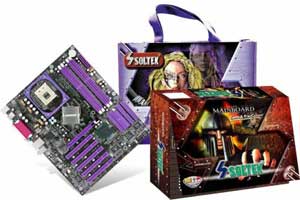
The Soltek SL-PT880Pro-FGR is one of the newest PRO series motherboards introduced by Soltek. To expand the product line, the PRO series have additional features to make them competitive with top-line boards from other manufacturers. There are also value versions of the PT880 available, called the SL-PT880E-R and -RL. The lower cost versions only support 2 DIMMs and do not include the Promise controller.
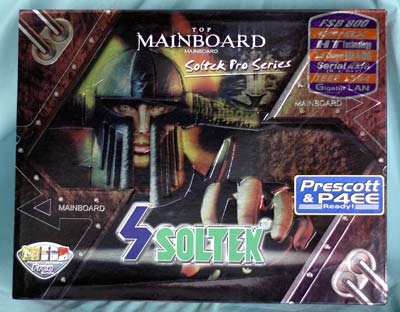
"Slick" is the only way to describe the new embossed foil, info flap package for the PT880Pro. In the past, Gigabyte has delivered some of the fanciest packaging that we have seen in their 6-Dual series. This Soltek package is in the same league. It is clear that Soltek wants to make the Pro series motherboards stand out from the rest of their line.
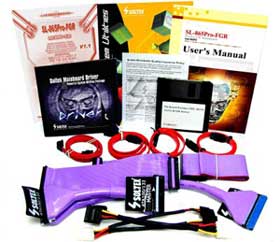
It looks like purple slots go with Pro for Soltek, creating a purple-on-black color scheme. The accessories also include a round purple IDE cable and a purple floppy cable.
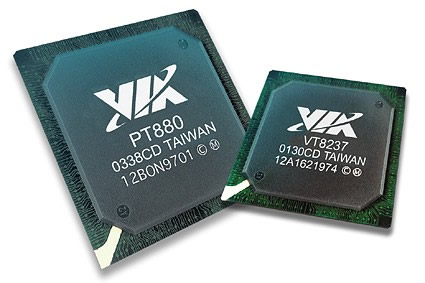
The PT880 Northbridge supports up to 4GB of non-ECC Dual-Channel memory. While this chipset can support ECC and up to 8GB of memory, Soltek decided not to implement ECC on the PT880Pro. The feature-rich VT8237 Southbridge has been covered in detail in Athlon 64 reviews. For more detailed information on the 8237, refer to Athlon64 Motherboards: First Look at Chaintech, FIC, and MSI. The 8237 supports 8 USB 2.0 ports, dual ATA133 IDE, Serial ATA with the option for RAID 0 and 1, and provides basic code for a 6-channel audio codec.
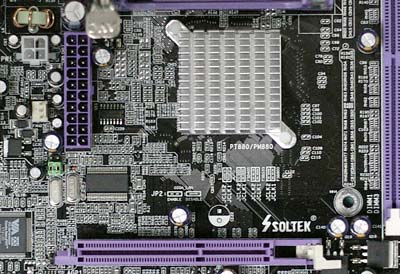
Soltek uses a very tall passive heatsink to cool the Northbridge instead of an active fan as we often see. There are arguments for and against both solutions, but there is a fan connector nearby if you choose to change the Northbridge cooling. We had no problem with overheating of the Northbridge during our testing.

The very full back panel of the Soltek includes 4 USB 2.0 ports, PS2 mouse and keyboard ports, 3 audio mini jacks for 6 speakers or mic and line, 2 serial ports, parallel port, Gigabit LAN, and a Firewire port. While there are headers on the board for 4 additional USB ports, and a second Firewire port, the brackets are an accessory and not included. There is also no header on the motherboard for SPDIF.
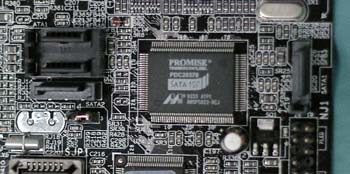
The Soltek PT880Pro provides support for up to 4 SATA drives in standalone or RAID configurations. Two SATA are supported by the 8237 Southbridge and two are supported by the Promise 20378 controller.
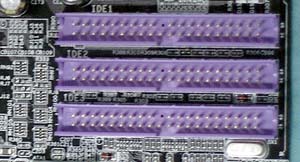
VT8237 supports up to 4 IDE devices and up to ATA133 speed. In addition, 2 more IDE devices are supported by the Promise controller - either as standalone IDE devices or IDE RAID. The Promise 20378 can also control 2 SATA drives plus 2 IDE drives configured as RAID 0+1.

The PT880Pro uses the VIA VT1616 Vinyl Six-Trac audio chip. The 1616 is the 18-bit junior member of the audio family. The top-line Envy24 would have been a better choice for a top-line board, but the 1616 is still very capable, providing 6-channel audio that exceeds Microsoft's WHQL logo requirements for junior member of the VIA Vinyl audio family, ALC658. VIA provides detailed information on the Vinyl Six-Trac capabilities at the VIA web site.
"The VIA Six-TRAC is a complete solution supporting the AC'97 2.2 specification with S/PDIF extension compliance. Enabling 6 channel outputs with 18-bit resolution the VIA VT1616 can support full 5.1 surround sound enabling theatre-quality home audio systems. For optimum playback performance the Six-TRAC analog mixer circuitry integrates stereo enhancement to provide a pleasing 3Ds surround sound effect for stereo media. Further provisions in the hardware allow for downmixing of 6-channel inputs such as DVDs into 4-channel, or even 2-channels outputs.While the chip supports SPDIF, there are no headers on the Soltek PT880Pro to implement this feature. With just 3 audio jacks, you will also be forced to give up Mic and Line capabilities to drive a 6-channel speaker setup.
An 18-bit independent rate stereo ADC enables 5 stereo and 2 mono analog line-level inputs allowing recording from sources such as microphones, CDs, line-ins etc. With sample rate converters on all channels the VIA Six-TRAC can be adjusted in 1Hz increments allowing exacting audio manipulation. To maintain full digital audio paths the VIA VT1616 has an IEC958 line driver for S/PDIF compressed digital or LPCM audio outputs."
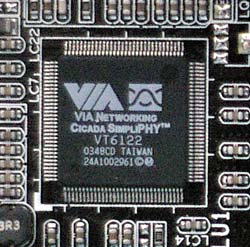
Gigabit LAN is provided by another VIA chip - the VT6122. 10/100/1000Mb data transfer rates are supported.

Four DIMM slots support two dual-channel memory banks that can handle unbuffered DIMMs up to DDR400 speed. This is the same configuration provided by Intel's 865/875 chipsets and the SiS655TX. VIA's Dual-Channel design is called DualStream 64, and VIA claims it provides fast, low-latency memory performance on par with Intel chipsets. The PT880 is also the first VIA chipset in recent memory to provide an asynchronous bus design. This means that the PCI/AGP frequency can be fixed at the 33/66 specification while the system and memory clocks are increased to higher levels. This has allowed Intel and SiS chipsets to reach incredible overclocks with the Pentium 4.
Board Layout: Soltek SL-PT880Pro-FGR
The basic layout of the Soltek SL-PT880Pro will work fine in most cases. However, there are a number of small problems that keep the layout from being in the same league as the top Asus boards.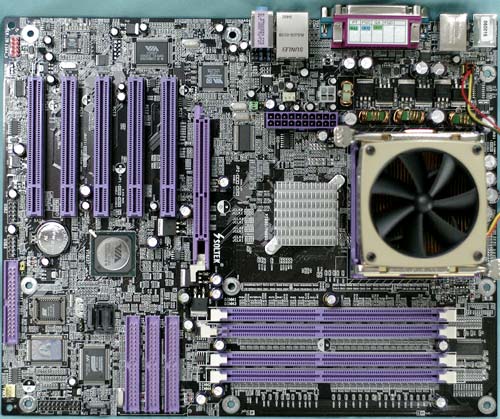
The PT880Pro is solid back with purple connectors and slots. This actually looks better in person than what it may sound to some readers.
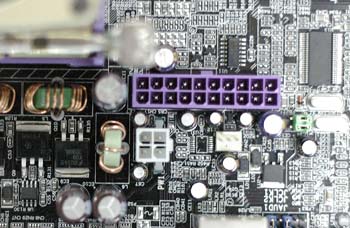
Soltek groups the ATX connector and 4-pin 12V connector between the CPU socket and the I/O connectors. Generally, we prefer these connectors on the upper right edge of the board as this works best in most case designs. We had no problem with the location used on this board with our mid-tower case, but you will need to be careful in some cases not to block CPU airflow.
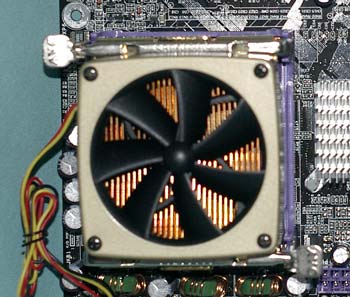
The CPU socket looks cramped, but it works much better than you would expect. The huge Zalman 700 mounted fine and cleared even the tall capacitors on the upper edge of the PT880Pro. If the Zalman fits, almost anything will work on this Soltek board.
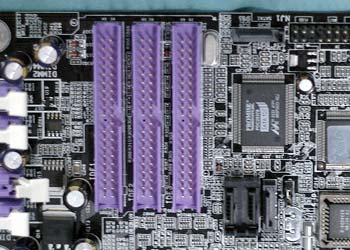
Generally, we prefer the IDE connectors on the upper right edge of the motherboard; Soltek places them at the lower left. This may present problems with short cables in some cases, but it worked fine in our mid-tower test box. The location of the IDE and SATA connectors means that your only chance for full-length cards is AGP and slots 4 and 5 only if you use both IDE and SATA ports. Full-length cards are rare these days, but they will fit in some slots if you require this feature.
Unfortunately, the floppy connector is located on the lower right of the board. This will work fine in some case designs, but it will be a difficult reach in tower cases. It is also a location that makes neat cabling difficult in most cases. VIA's Reference Boards seem to favor this lower edge floppy connector, which manufacturers then use in board designs. This is a bad location for a floppy connector in our opinion, but it is becoming a moot point as many are abandoning even having a floppy drive in their systems.
The Soltek has only 5 PCI slots, but it still places the 8X AGP too close to the DIMM slots. Thankfully, the DIMMs are closer to the edge than where we normally see them, so there is interference between the DIMMs and AGP slot only with the largest video cards. Still, it is no fun to have to remove a video card just to add memory or upgrade memory.
Soltek provided 3 fan connectors on the PT880Pro and they all 3 were in excellent locations for the system builder. It is also good to see USB and Firewire connectors at the bottom edge of the board instead of scattered between slots as we see all too often.
There is nothing really wrong with the Soltek layout that would keep us from buying the board, but the layout is not quite as refined as we would like to see on a board designed to be a flagship product. Soltek has been very responsive to suggestions in the past, and we're certain to see more refined layouts in future Soltek boards.
BIOS: Soltek SL-PT880Pro-FGR

Soltek uses the familiar Phoenix-Award BIOS on the PT880Pro, so navigation will be familiar for most users. Soltek is well-known for the tweaking options provided on their boards. You will find a complete selection on the PT880PRO, but some of the ranges could be improved.
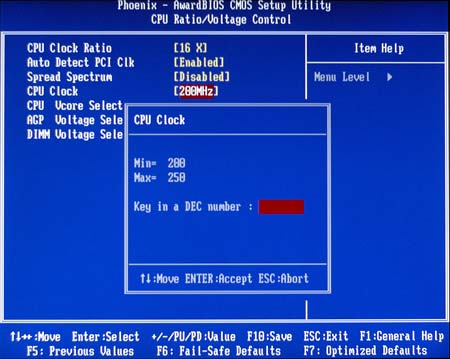
The adjustment that most disappointed us probably was a CPU adjustment range of just 200-250. With DDR550 memory available that runs at 275, and some 2.4 chips making it to 300 on the CPU, this looks like a very slim range for an Intel board. CPU speed and memory adjustments are under the "CPU Ratio/Voltage Control" tab. Since Intel CPU's are locked, there are no multiplier adjustments.
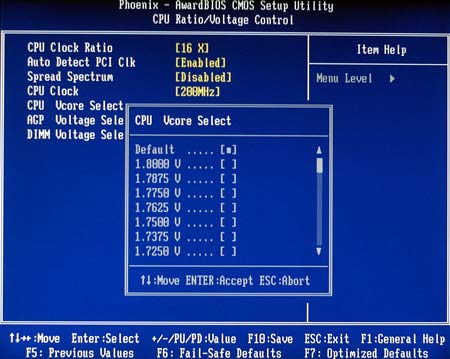
CPU voltage adjustments, on the other hand, are outstanding with a range from a low 0.8375V to 1.80V in fine 0.0125V increments. Whether your chip is a low-voltage Prescott or a Northwood, you should find what you need to overclock voltage in this range.
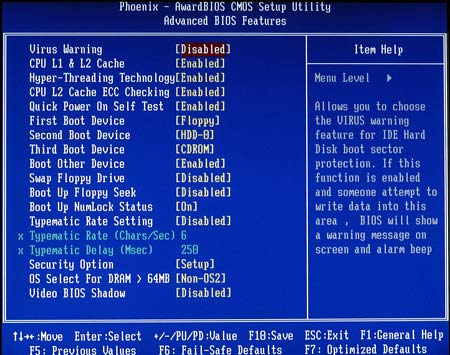
Advanced BIOS features allow control of boot devices and boot order.
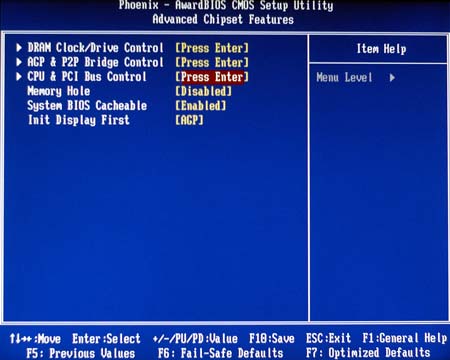
Many of the overclocking adjustments are under this tab, including the selection to adjust memory timings.
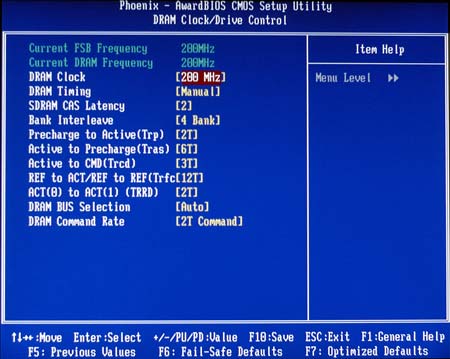
Soltek provides a very complete selection of memory timing adjustments. This will allow the most to be squeezed from whatever memory you use in the PT880Pro.
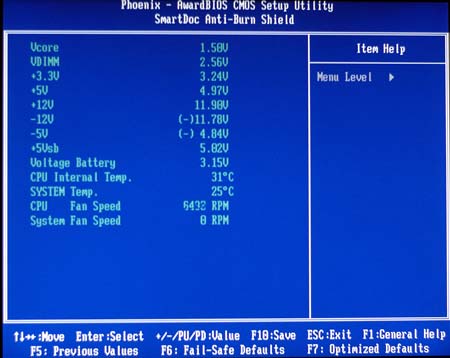
Soltek provides a Windows-based Red-Storm 2 overclocking utility and a Hardware Monitor for Windows. You can also check voltages and fan speeds in the BIOS Smart Doc section.
The BIOS options for the PT880Pro are very good, except for the limited range of CPU frequency adjustments. That should make more sense after we look at overclocking.
Tech Support and RMA: Soltek SL-PT880Pro-FGR
Our support evaluation procedure tries to determine the reponsiveness of manufacturers to Technical Support problems. Our procedure is as follows:The way our Tech Support evaluation works is first, we anonymously email the manufacturer's tech support address(es), obviously not using our AnandTech mail server to avoid any sort of preferential treatment. Our emails (we can and will send more than one just to make sure we're not getting the staff on an "off" day) all contain fixable problems that we've had with our motherboard. We allow the manufacturer up to 72 (business) hours to respond, and then we will report whether or not they responded within the time allotted, and if they were successful in fixing our problems. In case we don't receive a response before the review is published, any future responses will be added to the review, including the total time it took for the manufacturer to respond to our requests.
The idea here is to encourage manufacturers to improve their technical support as well as provide new criteria upon which to base your motherboard purchasing decisions. As motherboards become more similar everyday, we have to help separate the boys from the men in as many ways as possible. As usual, we're interested in your feedback on this and other parts of our reviews, so please do email us with your comments.
We still cannot find Soltek's RMA policy on their U.S. website. Soltek lists sales/support operations in Taiwan, Europe, and South America, but there are no listings for offices in the USA. Soltek tells us that RMA requests should be directed toward the dealer who sold you the board. In the event of problems there, requests can be addressed to [email protected]. The lack of an identifiable US office for Soltek is of concern, but we should also point out that our requests to their Taiwan headquarters were all answered promptly, and the Soltek staff was very helpful. FAQ's, downloads, and product information are available at the main site - you will be linked to this main site if you visit www.soltekusa.com.
Technical Support is also available by email, which is listed under "Contacts" at the main site. Soltek's tech support response time was not quite as good as we have seen in the past, but it was still excellent. Soltek Taiwan's response came in just 30 hours after our original email. The reply from the technical support representative was helpful and the advice given was useful and appropriate to the problem. The Technical Support Representative also came across as sincerely interested in solving our problem - something that is hard to measure, but always appropriate. In 3 recent Soltek reviews, the last 2 replies showed good technical grasp of our question, so it looks like Soltek Technical Support is improving in quality. The fast response times by Soltek in all 3 requests left a very positive impression of Soltek's commitment to customer satisfaction. We almost passed on even sending a request on this go-around because this board has not yet reached the US market. The danger in sending requests on pre-release products is that you will almost always get great response, since a request from the US on a pre-release board has to be from a reviewer. We did wait until the board showed up as a production model on the Soltek website to try to minimize this type of concern.
We reiterate our past advice regarding Soltek. With no US office, those who cannot find a local Soltek resource should send their Tech Support inquiries to the main site in Taiwan. If our experience is any indication, you will be pleased at the responsiveness that you will find in your contacts with Soltek.
Overclocking and Stress Testing: Soltek SL-PT880Pro-FGR
FSB Overclocking Results
The Soltek PT880Pro has all the ingredients for top-notch overclocking, so we were anxious to see what the board could do. With Intel chipsets and some boards with SiS655TX reaching incredible overclocks with P4 chips, we were expecting the same from the PT880 chipset.| Front Side Bus Overclocking Testbed | ||
| Default Voltage | Maximum Overclock | |
| Processor: | 2.4C Pentium 4 2.4GHz |
2.4C Pentium 4 2.4GHz |
| CPU Voltage: | 1.525V (default) | 1.6V (Maximum vCore) |
| Cooling: | OCZ Eliminator 2 | OCZ Eliminator 2 |
| Power Supply: | Antec TruePower 430W | Antec TruePower 430W |
| Maximum OC: | 2616MHz (+9%) 218FSB |
2654MHz (+10.5%) 221FSB |
Our overclocking chart needs a little bit of explanation. We first tested with a 3.2C that is known to do 3.7GHz (233x160 at default voltage). Our overclocks were a disappointing 218-220 and we needed a little extra voltage just to make it to 220. At first, we thought that the new VIA PCI/AGP lock was not working. Soltek checked operation of the asynchronous bus in their lab with an oscilloscope and found it to be working. We then checked it ourselves with PC Geiger, which also showed the PCI bus remaining fixed at 33.3MHz.
At that point, we swapped to our 2.4C that is used to test memory. You have seen this chip at 280-291 in memory testing, and we have had it over 300 in 5:4 testing. With this 2.4C, we were confident that we were completely eliminating the CPU and voltage as an overclocking issue. To our surprise, the 2.4C also topped out in the 218-222 range.
We can only conclude that VIA and/or Soltek have work to do on the overclocking capabilities of the PT880. With both the Intel and SiS chipsets reaching very high overclocks with the current Pentium 4 chips, the overclocking performance of the PT880 is a complete disappointment in comparison. Since we have found in the past that Soltek knows how to produce great overclocking boards, we suspect the issue lies with the PT880 chipset. It now appears that Soltek's decision to provide a CPU adjustment range only to 250 was not an oversight. Based on these results, 250 is an ambitious overclocking goal on this chipset and board.
Front Side Bus Stress Test Results:
As part of normal overclocking tests, a full range of stress tests and benchmarks were run to ensure the PT880Pro was stable at each overclocked FSB speed. This included Prime95 torture tests, and the addition of other tasks - data compression, various DX8 and DX9 games, and apps like Word and Excel - while Prime95 was running in the background. Finally, we ran our benchmark suite, which includes Veritest Winstone 2004 suite, Unreal Tournament 2003, SPECviewperf 7.1, and Aquamark 3. 218MHz was the highest overclock that we were able to achieve with the Soltek while running these tests at default voltage.Memory Stress Test Results:
The memory stress test is very basic, as it simply tests the ability of the PT880Pro to operate at its officially supported memory frequency (400MHz DDR) at the lowest supported memory timings that our Mushkin PC3500 Level 2 or OCZ PC3500 Platinum Ltd Modules will support. Memory stress testing was conducted by running RAM at 400MHz with 2 DIMM slots filled.| Stable DDR400 Timings - 2 DIMMs (2/4 DIMMs populated - DC mode) |
|
| Clock Speed: | 200MHz |
| Timing Mode: | N/A |
| CAS Latency: | 2.0 |
| Bank Interleave: | 4 |
| RAS to CAS Delay: | 3T |
| RAS Precharge: | 6T |
| Precharge Delay: | 2T |
| Command Rate: | 2T |
The PT880Pro was not completely stable with either the most aggressive 2-2-2-6 timings or 1T command rate. However, by slightly relaxing Ras-to-Cas to 3T and setting a 2T command rate, we were able to achieve complete stability. We had no problem running 2 DS 512MB DIMMs of our standard Mushkin PC3500 Level2 or OCZ PC3500 Platinum Ltd in the Soltek at these timings. Both of these memories were completely stable at the default memory voltage of 2.5V.
Filling all four available memory slots in a 2-bank dual-channel configuration is more strenuous on the memory subsystem than testing 2 DIMMs as a single DC bank. We were very pleased to find 4 DS DIMMs (2GB) of memory worked fine at the same timings we used for 2 DIMMs. Recent VIA chipsets have had some problems with all DIMM slots filled, but the PT880 seems to have solved that issue. Performance with all 4 DIMMs installed was very stable.
| Stable DDR400 Timings - - 4 DIMMs (4/4 DIMMs populated - 2 DC mode) |
|
| Clock Speed: | 200MHz |
| Timing Mode: | N/A |
| CAS Latency: | 2.0 |
| Bank Interleave: | 4 |
| RAS to CAS Delay: | 3T |
| RAS Precharge: | 6T |
| Precharge Delay: | 2T |
| Command Rate: | 2T |
We tested the memory timings with 2 DC banks (4 DS DIMMs) using several stress tests and general applications to guarantee stability. Prime95 torture tests were successfully run at the timings listed in the above charts. We also ran Sciencemark (memory tests only) and Super Pi. None of the stress tests created any stability problems for the Soltek PT880Pro at these memory timings. VIA has produced a very capable memory controller in the PT880 chipset.
3.2C: Performance Test Configuration
To provide the best comparison to past Performance Tests, two sets of benchmarks were run. Performance was first compared using a 3.2C Northwood processor to the competing Pentium 4 chipsets that we have tested. Results with the Soltek SL-PT800Pro-FGR were compared to two SiS655TX chipset boards and the top Intel 875 Asus P4C800-E.| Performance Test Configuration - 3.2C | |
| Processor(s): | Intel 3.2C (Northwood) |
| RAM: | 2 x 512MB Mushkin PC3500 Level II 2 x 512MB OCZ PC3500 Platinum Ltd. |
| Hard Drive(s): | Seagate 120GB 7200 RPM (8MB Buffer) |
| Video AGP & IDE Bus Master Drivers: | VIA Hyperion 4.51 (12-02-2003) Intel Chipset Drivers |
| Video Card(s): | ATI Radeon 9800 PRO 128MB (AGP 8X) |
| Video Drivers: | ATI Catalyst 4.1 |
| Operating System(s): | Windows XP Professional SP1 |
| Motherboards: | Soltek SL-PT880Pro-FGR (VIA PT880) Asus P4S800D-E (SiS 655TX) Gigabyte 8S655TX Ultra (SiS 655FX) Asus P4C800-E (Intel 875P) |
Benchmarks used either Mushkin PC3500 Level II or OCZ PC3500 Platinum Ltd memory modules. Both DIMMs use Winbond BH5 chips and perform virtually the same in our tests.
All performance tests were run with the ATI 9800 PRO 128MB video card with AGP Aperture set to 128MB with Fast Write enabled. Resolution in all benchmarks is 1024x768x32 unless otherwise noted.
Additions to Performance Tests
We have recently updated to Veritest Multimedia Content Creation Winstone 2004 and Veritest Business Winstone 2004 for system benchmarking.Game Benchmarks
We have added several new benchmarks to our standard Gaming tests. These include Halo, Microsoft's Direct X 9.0b game; Splinter Cell, a DX9 game; X2 Benchmark, a DX 8.1 game that includes Transform and Lighting effects; the DX9 Aquamark 3; and the DX 8.1 Comanche 4 benchmark. Since we have found that Comanche 4 can become video card limited at higher resolutions, we will only include benchmarks run with 4X anti-aliasing enabled to differentiate system performance better using our standard ATI Radeon 9800 PRO video card. We will be reporting more results at 1280 x 1024 resolution in future system and motherboard benchmarking where that resolution provides useful performance data.We have dropped Yeti Studios DX9 Gun Metal 2 from our standard motherboard and system benchmarks, since there are many other DX9 choices now available that measure system performance variations better. We will be adding other benchmarks in the near future.
3.2C: Content Creation, General Usage, and Memory Performance
Looking at the three chipsets represented here, the SiS655TX and Intel 875 have roughly equivalent performance, while the Soltek PT880Pro with the VIA PT880 chipset is a bit slower.
Science Mark 2 was recently updated, and we used the latest 9/23/03 build for our Memory testing. As we saw in earlier benchmarks in our SiS655TX review, SiS and Intel 875 are very close in both latency and memory bandwidth in ScienceMark tests. VIA's PT880 shows higher latency and slightly lower bandwidth than the other chipsets for Pentium 4. VIA latency is about 30% higher than Intel chipsets. However, this may be the result of the unique configuration for dual-channel that VIA has developed, since memory bandwidth is only about 6% lower than Intel.
3.2C: Gaming Performance and Media Encoding
The gaming area is not a particularly strong performer for the PT880PRO. When we tested the first production SiS655TX motherboards, we found they equaled or exceeded results with the top Intel 875 board. The PT880 equals or is slower than Intel's 875 chipset. It is the slowest of the 3 Dual-Channel chipsets in Quake 3, Aquamark 3, UT2003 Flyby and Botmatch, and X2. Performance is about even with the Intel 875 in Splinter Cell and Comanche 4.
Media Encoding performance is basically the same as the excellent performance we see with the Intel 875 chipset, which is high praise. Since we are now using XMpeg 5.03 with Divx 5.1.1, earlier tests with the SiS655TX could not be compared to these results.
3.2C: Workstation Performance
Performance of the PT880Pro is very comparable to that of the Intel chipset in the SPECviewperf suite. The Soltek leads in 3 of the 6 benchmarks, and is last in 3 of the benchmarks.
3.2E & 3.2EE: Performance Test Configuration
The Soltek PT880Pro also claims compatibility with the new Intel Prescott and EE processors. To test Performance in this configuration, we compared performance tests with the Soltek running a 3.2E and 3.2EE processors. These results were compared to benchmark results with these two CPUs on the Asus P4C800-E.| Performance Test Configuration - 3.2E & 3.2EE | |
| Processor(s): | Intel 3.2E (Prescott) Intel 3.2EE (Extreme Edition) |
| RAM: | 2 x 512MB Mushkin PC3500 Level II 2 x 512MB OCZ PC3500 Platinum Ltd. |
| Hard Drive(s): | Seagate 120GB 7200 RPM (8MB Buffer) |
| Video AGP & IDE Bus Master Drivers: | VIA Hyperion 4.51 (12-02-2003) Intel Chipset Drivers |
| Video Card(s): | ATI Radeon 9800 PRO 128MB (AGP 8X) |
| Video Drivers: | ATI Catalyst 4.1 |
| Operating System(s): | Windows XP Professional SP1 |
| Motherboards: | Soltek SL-PT880Pro-FGR (VIA PT880) Asus P4C800-E (Intel 875P) |
As we were already running 3 complete sets of benchmarks on the PT880Pro with the 3.2C, 3.2E, and 3.2EE, we did not rerun a complete set of benchmarks on a SiS655TX motherboard. While this would have been ideal and we will add these benchmarks in the future, it was simply too time-consuming for this already lengthy review. As a quick check, a 3.2E and 3.2EE was briefly tested in the Asus P4S800D-E to confirm compatibility with these new processors. The SiS655TX chipset Asus had no issues with the 3.2E or 3.2EE in our brief tests.
3.2E & 3.2EE: Content Creation and General Usage Performance
Content Creation and General Usage results with the 3.2EE are basically the same pattern we saw with the 3.2C, with the PT880 trailing Intel 875 by a small margin. However, the results with Prescott are a bit strange on the VIA chipset. We cannot explain the extremely low results with the PT880Pro General Usage or Office 2004 benchmarks. We repeated the tests several times and achieved the same unusual results.
Perhaps there are some additional BIOS optimizations that may be needed for best performance of the Prescott on the PT880.
3.2E & 3.2EE: Gaming Performance and Media Encoding
The Gaming performance of the 3.2E and 3.2EE pretty much mirrors what we found in tests with the 3.2C.
3.2E & 3.2EE: Workstation Performance
We see a different pattern in Workstation Performance of the Soltek PT880Pro running the 3.2E and 3.2EE. With the 3.2C, the PT880 led in 3 of the 6 benchmarks; with the 3.2E and 3.2EE, the Intel 875 is the top performer in all 6 tests. This again suggests that the PT880Pro may need a bit more tweaking for Prescott and EE processors. With a more mature BIOS, we will likely see even better performance in Workstation benchmarks with the 2 newest processors.
Final Words
VIA has definitely produced a chipset that is competitive with the best from Intel with the PT880. While it is not the fastest chipset that we have tested for the Pentium 4, it is definitely competitive in every stock performance area with Intel's 875. At a price that is less than even Intel's lower priced 865 chipset, this is quite an accomplishment. We congratulate VIA for producing a great chipset that is feature-rich and competes very well with the leader. For the vast majority of users who do not overclock, the VIA PT880 will do exactly what they want with their Pentium 4, and your Intel platform can be selected between VIA, SiS, and Intel based on features.The PT880 also proved its compatibility with Intel's latest Prescott and Extreme Edition processors. Both the 3.2E and 3.2EE ran fine on the Soltek PT880Pro, though there are a few areas where additional tweaking may be necessary for best performance of Prescott.
There is an Achilles Heel, however. Intel has achieved almost legendary overclocking abilities with Northwood processors on their 875/865 chipsets; there are many enthusiasts who happily run low-cost 2.4C processors at 3.0GHz and above. Even Intel's top-line processors often achieve 400MHz to 600MHz overclocks at default voltage on Intel 875/865 chipsets. To be a "value" choice in this arena requires, for many, a chipset that can achieve these same levels of performance. Our overclocking results with PT880 were dismal. This time around, it is not a missing PCI/AGP lock that is holding it back; we confirmed the PCI is indeed fixed on this PT880 board. We do not know if the poor overclocking is a problem with the motherboard or the chipset, but since Soltek is a company well-versed in overclocking, we suspect it is the chipset that just can't deliver the overclocks many users demand. We hope this is just a problem with early silicon, and that VIA will quickly address the one issue that could hold back PT880 from the success it otherwise deserves.
As a motherboard, the Soltek SL-PT880Pro-FGR is a great product. As one of Soltek's first offerings in their PRO series, it succeeds in presenting a new image for Soltek as a company that also makes top-line boards. We would suggest that Soltek consider including USB brackets and SPDIF in their package to make it even more attractive. It also would have been a more attractive board if Soltek had used the VIA Envy24 audio chip instead of the competent, but lower performing, VT1616. These are small complaints, however. Overall, the feature set of the SL-PT880Pro-FGR is outstanding. It delivers what most buyers are looking for, and it stands up well to the best from any manufacturer.
Despite the success of VIA with PT880, we also need to step back and take a look at the larger picture. Socket 478 is nearing the end as the top Intel socket, with Socket 775 coming in April. This means VIA's 478 solution that finally supports Dual-Channel is quite late. Perhaps VIA's plan is to dominate in the sales of 478 boards after 775 because this will continue for quite a while with both top-end, and ultimately, value boards. Despite the fact that VIA's solution is competent, it may be too late. We're certain VIA is aware of this, and perhaps PT880 is a "credibility" release, to establish that VIA can deliver a decent chipset for Intel, so consumers will embrace the upcoming VIA Socket 775 chipset.
There is also another factor. No matter how we look at the performance results, the SiS655TX is still the best performing chipset for the Pentium 4. SiS655TX, Intel 875/865, and VIA PT880 are all close in performance, and any of the three would be a good choice for a new Pentium 4 system. The performance differences are generally small, but the SiS655TX is the leader in most benchmarks. This will matter to buyers today, but it may not matter at all in a few months when Socket 775 is the performance socket and consumers are mainly shopping for price with a ton of features.
In the end, VIA PT880, SiS655TX, and Intel 875/865 are all pretty close in performance. You can buy any of the 3 based on features if you plan to run your Pentium 4 processor at stock speeds or only mildly overclock. If you plan more serious overclocking, then you should choose an Intel 875/865 motherboard or one of the better SiS655TX boards.







